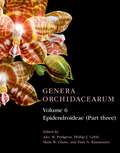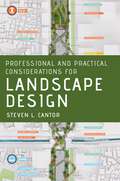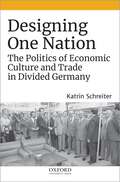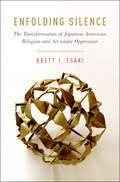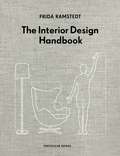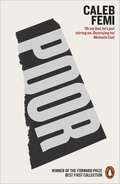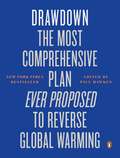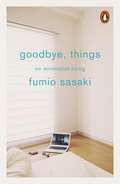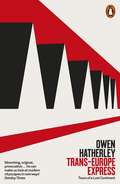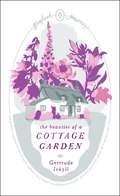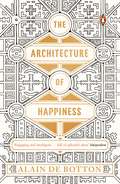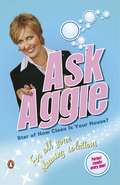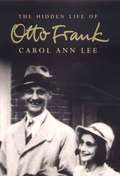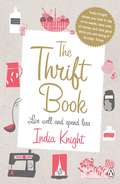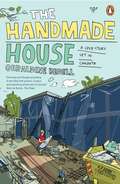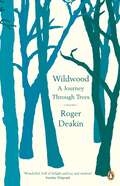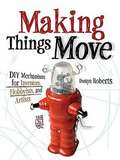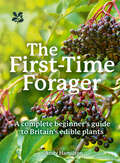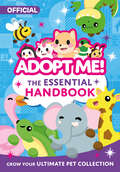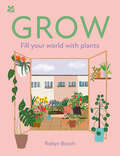- Table View
- List View
Genera Orchidacearum Volume 6: Epidendroideae (part 3) (Genera Orchidacearum)
by Alec M. Pridgeon Phillip J. Cribb Mark W. Chase Finn N. RasmussenFor centuries orchids have been among the most popular of plant families, with thousands of species and hybrids cultivated worldwide for the diversity, beauty, and intricacy of their flowers. The Genera Orchidacearum series represents a robust and natural classification of the orchids, something that has eluded plant scientists and orchid enthusiasts for years. The editors, who are all distinguished orchid specialists, incorporate a wealth of new DNA data into a truly phylogenetic classification, identifying the areas and taxa that merit additional work. To this end, they have invited several international specialists to contribute in their particular areas of expertise. Each volume provides comprehensive coverage of one or two orchid subfamilies, and the series as a whole will be an indispensable reference tool for scientists, orchid breeders, and growers. Orchidaceae is the largest monocotyledon family and perhaps the largest plant family in terms of number of species, approximately 25,000. Although the fossil record is limited, active molecular research in recent years has unravelled many of the complexities and phylogenetics of this cosmopolitan plant family. This sixth and final volume treats 140 genera in tribes Dendrobieae and Vandeae of the largest subfamily, Epidendroideae, including some of the showiest orchids often used in hybridizing. Comprehensive treatments are provided for each genus, which include complete nomenclature, description, distribution (with map), anatomy, palynology, cytogenetics, phytochemistry, phylogenetics, pollination, ecology, and economic uses. Cultivation notes are included for those genera known to be in hobbyist collections. Genera are beautifully illustrated with line drawings and colour photographs. An Addendum updates a few generic accounts published in past volumes. A cumulative glossary, list of generic synonyms with their equivalents, and list of all series contributors round out this final volume in the series.
Professional and Practical Considerations for Landscape Design
by Steven L. CantorDrawing on decades of professional practice and teaching experience, Steven L. Cantor's Professional and Practical Considerations for Landscape Design explains the field of landscape architecture, outlining with authority how to turn drawings of designs into creative, purposeful, and striking landscapes and landforms in today's world. This comprehensive guide consists of everything a young professional might encounter from conception through final project archiving, ensuring readers have both the tools necessary to keep up with advancements in the field and the practical business knowledge to build life-long partnerships. Each of the book's concise chapters emphasize a specific aspect of landscape architecture practice, from the administration of designs for contracts, areas of practice, human resources, marketing, construction materials, sustainability and ethics. Each chapter is written in a style that best suits the material. Alongside detailed definitions and practical "do's and don'ts" are 30 complex sample problems ranging in difficulty for both individuals and groups. An array of original photographs and clear examples in both black and white and color articulate standards and inspire future possibilities, featuring the work of Vicky Chan, founder of Avoid Obvious Architects, and Richard Alomar, Associate Professor of Landscape Architecture at Rutgers and co-founder of New York Urban Sketchers. By combining the author's unique depth of knowledge with real-world case studies from America, Asia, and Europe, Professional and Practical Considerations for Landscape Design is an up-to-date resource for every level of reader, from students in landscape architecture programs to professionals working in public or private practice, engineering, consulting, or contracting.
Designing One Nation: The Politics of Economic Culture and Trade in Divided Germany
by Katrin SchreiterThis is an open access title available under the terms of a CC BY-NC-ND 4.0 International License. It is free to read at Oxford Scholarship Online and offered as a free PDF download from OUP and selected open access locations, thanks to a generous grant from the Andrew W. Mellon Foundation. The histories of East and West Germany traditionally emphasize the Cold War rivalries between the communist and capitalist nations. Yet, even as the countries diverged in their political directions, they had to create new ways of working together economically. In Designing One Nation, Katrin Schreiter examines the material culture of increasing economic contacts in divided Germany from the 1940s until the 1990s. Trade events, such as fairs and product shows, became one of the few venues for sustained links and knowledge between the two countries after the building of the Berlin Wall. Schreiter uses industrial design, epitomized by the furniture industry, to show how a network of politicians, entrepreneurs, and cultural brokers attempted to nationally re-inscribe their production cultures, define a postwar German identity, and regain economic stability and political influence in postwar Europe. What started as a competition for ideological superiority between East and West Germany quickly turned into a shared, politically legitimizing quest for an untainted post-fascist modernity. This work follows products from the drawing board into the homes of ordinary Germans to offer insights into how converging visions of German industrial modernity created shared expectations about economic progress and living standards. Schreiter reveals how intra-German and European trade policies drove the creation of products and generated a certain convergence of East and West German taste by the 1980s. Drawing on a wide range of sources from governments, furniture firms, industrial design councils, home lifestyle magazines, and design exhibitions, Designing One Nation argues that an economic culture linked the two Germanies even before reunification in 1990.
Designing One Nation: The Politics of Economic Culture and Trade in Divided Germany
by Katrin SchreiterThis is an open access title available under the terms of a CC BY-NC-ND 4.0 International License. It is free to read at Oxford Scholarship Online and offered as a free PDF download from OUP and selected open access locations, thanks to a generous grant from the Andrew W. Mellon Foundation. The histories of East and West Germany traditionally emphasize the Cold War rivalries between the communist and capitalist nations. Yet, even as the countries diverged in their political directions, they had to create new ways of working together economically. In Designing One Nation, Katrin Schreiter examines the material culture of increasing economic contacts in divided Germany from the 1940s until the 1990s. Trade events, such as fairs and product shows, became one of the few venues for sustained links and knowledge between the two countries after the building of the Berlin Wall. Schreiter uses industrial design, epitomized by the furniture industry, to show how a network of politicians, entrepreneurs, and cultural brokers attempted to nationally re-inscribe their production cultures, define a postwar German identity, and regain economic stability and political influence in postwar Europe. What started as a competition for ideological superiority between East and West Germany quickly turned into a shared, politically legitimizing quest for an untainted post-fascist modernity. This work follows products from the drawing board into the homes of ordinary Germans to offer insights into how converging visions of German industrial modernity created shared expectations about economic progress and living standards. Schreiter reveals how intra-German and European trade policies drove the creation of products and generated a certain convergence of East and West German taste by the 1980s. Drawing on a wide range of sources from governments, furniture firms, industrial design councils, home lifestyle magazines, and design exhibitions, Designing One Nation argues that an economic culture linked the two Germanies even before reunification in 1990.
Professional and Practical Considerations for Landscape Design
by Steven L. CantorDrawing on decades of professional practice and teaching experience, Steven L. Cantor's Professional and Practical Considerations for Landscape Design explains the field of landscape architecture, outlining with authority how to turn drawings of designs into creative, purposeful, and striking landscapes and landforms in today's world. This comprehensive guide consists of everything a young professional might encounter from conception through final project archiving, ensuring readers have both the tools necessary to keep up with advancements in the field and the practical business knowledge to build life-long partnerships. Each of the book's concise chapters emphasize a specific aspect of landscape architecture practice, from the administration of designs for contracts, areas of practice, human resources, marketing, construction materials, sustainability and ethics. Each chapter is written in a style that best suits the material. Alongside detailed definitions and practical "do's and don'ts" are 30 complex sample problems ranging in difficulty for both individuals and groups. An array of original photographs and clear examples in both black and white and color articulate standards and inspire future possibilities, featuring the work of Vicky Chan, founder of Avoid Obvious Architects, and Richard Alomar, Associate Professor of Landscape Architecture at Rutgers and co-founder of New York Urban Sketchers. By combining the author's unique depth of knowledge with real-world case studies from America, Asia, and Europe, Professional and Practical Considerations for Landscape Design is an up-to-date resource for every level of reader, from students in landscape architecture programs to professionals working in public or private practice, engineering, consulting, or contracting.
Enfolding Silence: The Transformation of Japanese American Religion and Art under Oppression (AAR Academy Series)
by Brett J. EsakiThis book demonstrates how Japanese Americans have developed traditions of complex silences to survive historic moments of racial and religious oppression and how they continue to adapt these traditions today. Brett Esaki offers four case studies of Japanese American art-gardening, origami, jazz, and monuments-and examines how each artistic practice has responded to a historic moment of oppression. He finds that these artistic silences incorporate and convey obfuscated and hybridized religious ideas from Buddhism, Christianity, Confucianism, Shinto, indigenous religions, and contemporary spirituality. While silence is often thought of as the binary opposite and absence of sound, Esaki offers a theory of non-binary silence that articulates how multidimensional silences are formed and how they function. He argues that non-binary silences have allowed Japanese Americans to disguise, adapt, and innovate religious resources in order to negotiate racism and oppressive ideologies from both the United States and Japan. Drawing from the fields of religious studies, ethnic studies, theology, anthropology, art, music, history, and psychoanalysis, this book highlights the ways in which silence has been used to communicate the complex emotions of historical survival, religious experience, and artistic inspiration.
Enfolding Silence: The Transformation of Japanese American Religion and Art under Oppression (AAR Academy Series)
by Brett J. EsakiThis book demonstrates how Japanese Americans have developed traditions of complex silences to survive historic moments of racial and religious oppression and how they continue to adapt these traditions today. Brett Esaki offers four case studies of Japanese American art-gardening, origami, jazz, and monuments-and examines how each artistic practice has responded to a historic moment of oppression. He finds that these artistic silences incorporate and convey obfuscated and hybridized religious ideas from Buddhism, Christianity, Confucianism, Shinto, indigenous religions, and contemporary spirituality. While silence is often thought of as the binary opposite and absence of sound, Esaki offers a theory of non-binary silence that articulates how multidimensional silences are formed and how they function. He argues that non-binary silences have allowed Japanese Americans to disguise, adapt, and innovate religious resources in order to negotiate racism and oppressive ideologies from both the United States and Japan. Drawing from the fields of religious studies, ethnic studies, theology, anthropology, art, music, history, and psychoanalysis, this book highlights the ways in which silence has been used to communicate the complex emotions of historical survival, religious experience, and artistic inspiration.
The Interior Design Handbook: Furnish, Decorate, And Style Your Space
by Frida RamstedtTHE BESTSELLING SWEDISH PHENOMENONWhat looks good and why?Design consultant Frida Ramstedt runs Scandinavia's leading interior design blog. In this book she distils the secrets of successful interior design and styling to help you create a home that works best for your space, taste and lifestyle. Filled with practical tips, rules-of-thumb and tricks of the trade, The Interior Design Handbook will help you to think like a professional designer.
Poor
by Caleb Femi'An urban romantic ... powerful' Dazed & Confused 'A poet of truth and rage, heartbreak and joy' Max PorterWhat is it like to grow up in a place where the same police officer who told your primary school class they were special stops and searches you at 13 because 'you fit the description of a man' - and where it is possible to walk two and a half miles through an estate of 1,444 homes without ever touching the ground?In Poor, Caleb Femi combines poetry and original photography to explore the trials, tribulations, dreams and joys of young Black boys in twenty-first century Peckham. He contemplates the ways in which they are informed by the built environment of concrete walls and gentrifying neighbourhoods that form their stage, writes a coded, near-mythical history of the personalities and sagas of his South London youth, and pays tribute to the rappers and artists who spoke to their lives.Above all, this is a tribute to the world that shaped a poet, and to the people forging difficult lives and finding magic within it. As Femi writes in one of the final poems of this book: 'I have never loved anything the way I love the endz.'
Drawdown: The Most Comprehensive Plan Ever Proposed to Reverse Global Warming
by Paul HawkenNEW YORK TIMES BESTSELLERFor the first time ever, an international coalition of leading researchers, scientists and policymakers has come together to offer a set of realistic and bold solutions to climate change. All of the techniques described here - some well-known, some you may have never heard of - are economically viable, and communities throughout the world are already enacting them. From revolutionizing how we produce and consume food to educating girls in lower-income countries, these are all solutions which, if deployed collectively on a global scale over the next thirty years, could not just slow the earth's warming, but reach drawdown: the point when greenhouse gasses in the atmosphere peak and begin todecline. So what are we waiting for?
Goodbye, Things: On Minimalist Living
by Fumio Sasaki'Meet the new king of decluttering' - The Times'Take your spring cleaning to the next level with Goodbye, Things by Fumio Sasaki' - Parade'There's happiness in having less. If you are anything like how I used to be - miserable, constantly comparing yourself with others, or just believing your life sucks - I think you should try saying goodbye to some of your things'Fumio Sasaki is a writer in his thirties who lives in a tiny studio in Tokyo with three shirts, four pairs of trousers, four pairs of socks and not much else. A few years ago, he realised that owning so much stuff was weighing him down - so he started to get rid of it.In this hit Japanese bestseller, Sasaki explores the philosophy behind minimalism and offers a set of straightforward rules - discard it if you haven't used it in a year; be a borrower; find your uniform; keep photos of the things you love - that can help all of us lead simpler, happier, more fulfilled lives.
Trans-Europe Express: Tours of a Lost Continent
by Owen Hatherley'A scathing, lively and timely look at the "European city", from one of our most provocative voices on culture and architecture today' Owen JonesA searching, timely account of the condition of contemporary Europe, told through the landscapes of its citiesOver the past twenty years European cities have become the envy of the world: a Kraftwerk Utopia of historic centres, supermodernist concert halls, imaginative public spaces and futuristic egalitarian housing estates which, interconnected by high-speed trains traversing open borders, have a combination of order and pleasure which is exceptionally unusual elsewhere.In Trans-Europe Express, Owen Hatherley sets out to explore the European city across the entire continent, to see what exactly makes it so different to the Anglo-Saxon norm - the unplanned, car-centred, developer-oriented spaces common to the US, Ireland, UK and Australia. Attempting to define the European city, Hatherley finds a continent divided both within the EU and outside it. 'The latest heir to Ruskin.' - Boyd Tonkin, Independent 'Hatherley is the most informed, opinionated and acerbic guide you could wish for.' - Hugh Pearman, Sunday Times 'Can one talk yet of vintage Hatherley? Yes, one can. Here are all the properties that have made him one of the most distinctive writers in England - not just 'architectural writers', but writers full stop: acuity, contrariness, observational rigour, frankness and beautifully wrought prose.' - Jonathan Meades
The Beauties of a Cottage Garden
by Gertrude JekyllThis is a celebration of the beauties and possibilities of Heliotrope and Honeysuckle, Auricula, Snapdragon, Spanish Iris and Corydalis, and all the other plants that enliven and exalt the gardens of England. Gertrude Jekyll gives good advice on how to make a garden a place of repose and pleasure. Writing with enthusiasm on the colours and scents of flowers, on the frustrations (and delights) of weeding and on the debasing influence of flower shows, she is practical, wise and entertaining in equal measure.Generations of inhabitants have helped shape the English countryside - but it has profoundly shaped us too.It has provoked a huge variety of responses from artists, writers, musicians and people who live and work on the land - as well as those who are travelling through it.English Journeys celebrates this long tradition with a series of twenty books on all aspects of the countryside, from stargazey pie and country churches, to man's relationship with nature and songs celebrating the patterns of the countryside (as well as ghosts and love-struck soldiers).
The Architecture of Happiness: The Architecture Of Happiness (Vintage International Series)
by Alain De BottonThe Architecture of Happiness is Alain de Botton's exploration of the hidden links between buildings and our well beingBestselling author Alain de Botton has written about love, travel, status and how philosophy can console us. Now he turns his attention to one of our most intense but often hidden love affairs: with our houses and their furnishings. He asks: What makes a house truly beautiful?Why are many new houses so ugly?Why do we argue so bitterly about sofas and pictures - and can differences of taste ever be satisfactorily resolved?Will minimalism make us happier than ornaments? To answer these questions and many more, de Botton looks at buildings across the world, from medieval wooden huts to modern skyscrapers; he examines sofas and cathedrals, tea sets and office complexes, and teases out a host of often surprising philosophical insights. The Architecture of Happiness will take you on a beguiling tour through the history and psychology of architecture and interior design, and will forever alter your relationship with buildings. It will change the way you look at your current home - and help you make the right decisions about your next one.'Engaging and intelligent . . . full of splendid ideas, happily and beautifully expressed'IndependentAlain de Botton was born in 1969 and is the author of non-fiction essays on themes ranging from love and travel to architecture and philosophy. His bestselling books include Essays in Love; The Romantic Movement; Kiss and Tell; Status Anxiety; How Proust Can Change Your Life; The Pleasures and Sorrows of Work; The Art of Travel; The Architecture of Happiness and Religion for Atheists. He lives in London and founded The School of Life (www.theschooloflife.com) and Living Architecture (www.living-architecture.co.uk). For more information, consult www.alaindebotton.com.
Ask Aggie: For All Your Cleaning Solutions
by Aggie MacKenzieHundreds of solutions to all your housekeeping needs! Banish those stains and transform your home into a palace of sparkling surfaces, clutter-free cupboards and carpets to be proud of. From ovens to fridges to bathrooms, red wine rings, and foul smelling microwaves - Aggie has all the answers to any cleaning question you can think of. From top to bottom, inside and outside, you'll find oodles of nifty ideas to take the drudgery out of cleaning. Erase each and every one of your domestic nightmares - after all, nobody knows housekeeping quite like Aggie!
The Hidden Life of Otto Frank
by Carol Ann LeeOtto Frank was the father of the most famous girl of the 20th Century. It was he who found her diaries after her death and his determination to see them published around the world. This is the first time his story has been told.Born into a prosperous Jewish family in Berlin, his life was a portrait in miniature of the century: decorated after the Battle of the Somme, forced to flee Germany in the 1930s, betrayed and imprisoned by the Nazis in the Holocaust and finally gaining recognition bybearing witness to the century's horrors though the writings of his young daughter.Carol Ann Lee has written a powerful biography of an extraordinary man's life caught up in history.
The Thrift Book: Live Well and Spend Less
by India KnightThe Thrift Book is a guide to how to live well while spending less by bestselling writer India Knight.Feeling poor because of the credit crunch? Feeling guilty because of global warming? Feeling like you'd like to tighten your belt, but aren't ready to embrace DIY macramé handbags? No need to panic. Put down the economy mince and buy this book instead - it's a blueprint for living beautifully, while saving money and easing your conscience. India Knight will show you:- How to make wonderful dinners with every little money- How to dress on a budget and still look fabulous- How to make friends and start sharing with your neighbours- How to holiday imaginatively - with barely a carbon footprintTry it - you have nothing to lose but your overdraft.'A blueprint for living well, however broke you are, with thrifty tips on looking fab, cooking, pampering and partying' Cosmopolitan'The Thrift Book might be the only sure-fire investment out there' Harper's Bazaar'A triumphant treat and a useful and sensible manual' IndependentIndia Knight is the author of four novels: My Life on a Plate, Don't You Want Me, Comfort and Joy and Mutton. Her non-fiction books include The Shops, the bestselling diet book Neris and India's Idiot-Proof Diet, the accompanying bestselling cookbook Neris and India's Idiot-Proof Diet Cookbook and The Thrift Book. India is a columnist for the Sunday Times and lives in London with her three children.Follow India on Twitter @indiaknight or on her blog at http://indiaknight.tumblr.com.
The Handmade House: A Love Story Set in Concrete
by Geraldine Bedell"We didn't intend to build a house. We just wanted to move - somewhere a bit bigger, with more of a garden: commonplace enough ambitions, especially for families with young children, especially in Britain, where property is wealth, and so, in some vague and unexamined sense, identity. Not that we were thinking about anything like that." The true and very funny story of how journalist, Geraldine Bedell and her husband Charlie Leadbeater, with no savings and no knowledge of architecture nearly make themselves bankrupt in an attempt to build their dream home. Far more than that, it's about the ultimate fantasy - creating your own made to measure living space. The Handmade House tells the story, alternately comical and horrifying, of one family's ambitious and inept attempt to build the perfect home.
Wildwood: A Journey Through Trees
by Roger DeakinRoger Deakin's Wildwood is a much loved classic of nature writingWildwood is about the element wood, as it exists in nature, in our souls, in our culture and our lives.From the walnut tree at his Suffolk home, Roger Deakin embarks upon a quest that takes him through Britain, across Europe, to Central Asia and Australia, in search of what lies behind man's profound and enduring connection with wood and with trees.Meeting woodlanders of all kinds, he lives in shacks and cabins, travels in search of the wild apple groves of Kazakhstan, goes coppicing in Suffolk, swims beneath the walnut trees of the Haut-Languedoc, and hunts bush plums with Aboriginal women in the outback.Perfect for fans of Robert Macfarlane and Colin Tudge, Roger Deakin's unmatched exploration of our relationship with trees is autobiography, history, traveller's tale and incisive work in natural history. It will take you into the heart of the woods, where we go 'to grow, learn and change''Enthralling' Will Self, New Statesman'Extraordinary . . . some of the finest naturalist writing for many years' Independent'Masterful, fascinating, excellent' Guardian'An excellent read - lyrical and literate and full of social and historical insights of all kinds' Colin Tudge, Financial Times'Enchanting, very funny, every page carries a fascinating nugget. Should serve to make us appreciate more keenly all that we have here on earth . . . one of the greatest of all nature writers' Craig Brown, Mail on Sunday'Breathtaking, vividly written . . . reading Wildwood is an elegiac experience' Sunday TimesRoger Deakin, who died in August 2006, shortly after completing the manuscript for Wildwood, was a writer, broadcaster and film-maker with a particular interest in nature and the environment. He lived for many years in Suffolk, where he swam regularly in his moat, in the river Waveney and in the sea, in between travelling widely through the landscapes he writes about in Wildwood. He is the author of Waterlog, Wildwood and Notes from Walnut Tree Farm.
Making Things Move DIY Mechanisms (PDF)
by Dustyn RobertsIn Making Things Move: DIY Mechanisms for Inventors, Hobbyists, and Artists, you'll learn how to successfully build moving mechanisms through non-technical explanations, examples, and do-it-yourself projects--from kinetic art installations to creative toys to energy-harvesting devices. Photographs, illustrations, screen shots, and images of 3D models are included for each project. This unique resource emphasizes using off-the-shelf components, readily available materials, and accessible fabrication techniques. Simple projects give you hands-on practice applying the skills covered in each chapter, and more complex projects at the end of the book incorporate topics from multiple chapters. Turn your imaginative ideas into reality with help from this practical, inventive guide.
The First-Time Forager: A Complete Beginner's Guide To Britain's Edible Plants (National Trust)
by Andy HamiltonA friendly, honest guide for wary would-be foragers Only plants that are easy to find, easy to identify and tasty Clear photographic guides to the species
Positively Green: Everyday tips to help the planet and calm climate anxiety (National Trust)
by Sarah LaBrecque National Trust BooksPositively Green is a guide to caring for the planet – and yourself.
The Essential Handbook (Adopt Me!)
by Uplift GamesAn essential game companion for new players and long-time fans of the popular online game, Adopt Me!
GROW: Fill your world with plants (National Trust)
by Robyn Booth National Trust BooksDiscover the joy of growing and using plants indoors and outdoors, no matter how limited your space.
